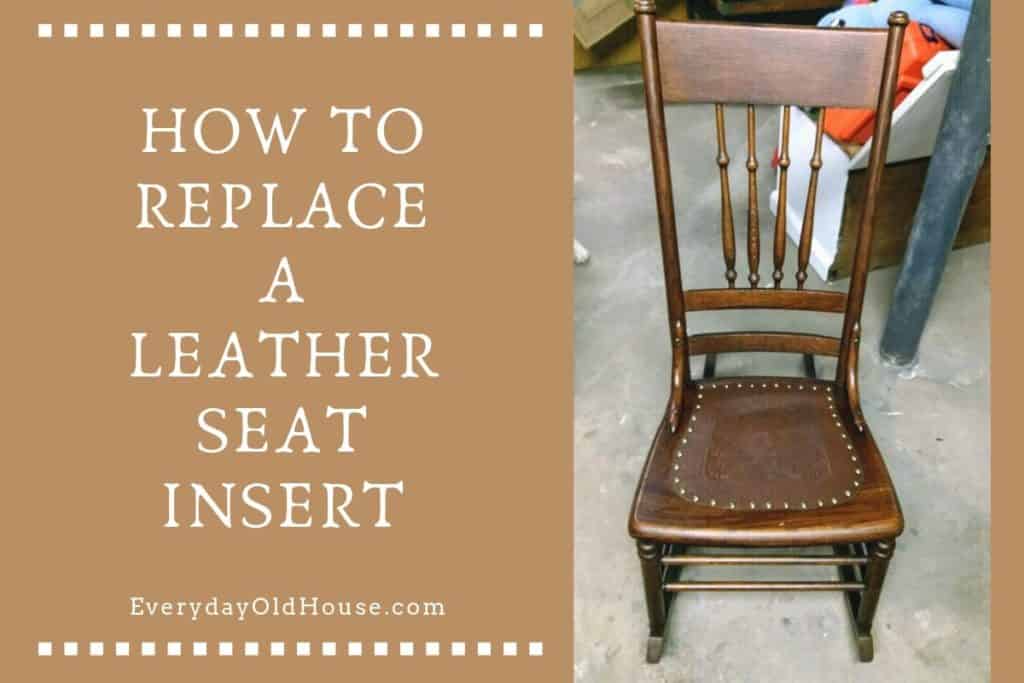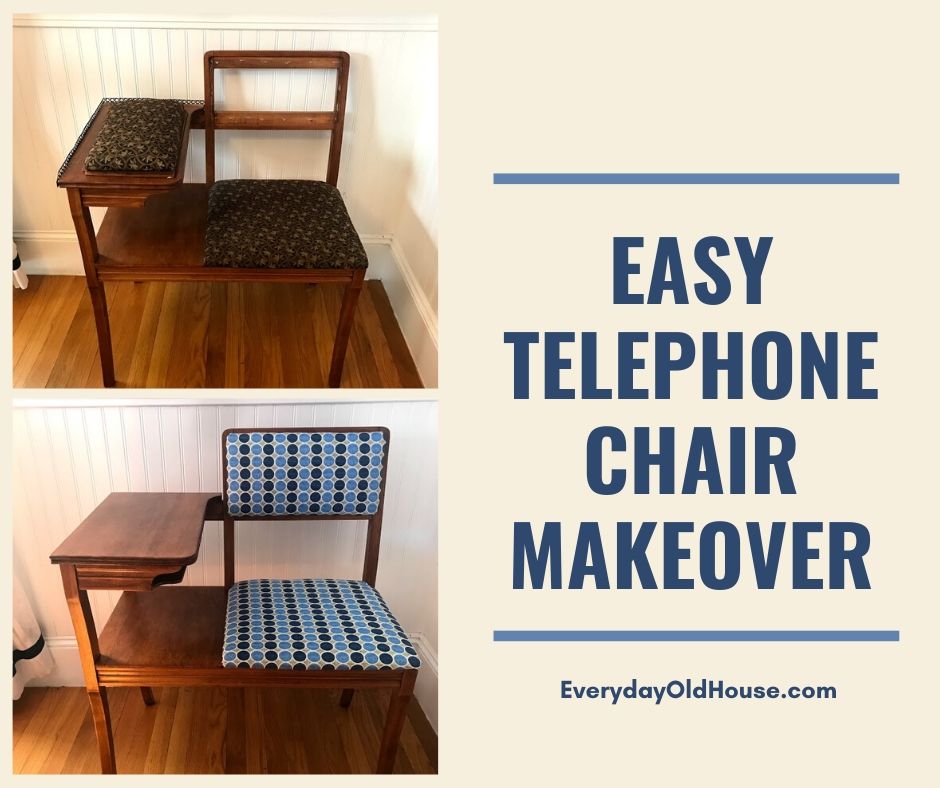Last Updated on November 22, 2023
As a newbie antique furniture restorer, I have a lot to learn (and I’m ready!). I love saving wood furniture destined for the landfill and bringing it back to life. Like this gorgeous chair below that I found on a neighbor’s curb. With a little advice from a Facebook antique restoration group, I’ll show you how I learned to restore dull tiger oak furniture.

This post contains affiliate links, including but not limited to, Amazon Associates. As such, I earn from qualifying purchases. Full disclosure located here.
Backstory
Up the hill from my house stands is a gorgeous stucco English cottage-style mansion on the National Register of Historic Places. The house was built around 1910-1913 and owned by Elizabeth Boit. Recognized by Harvard Business School as one of the 20th centuries “Great American Business Owners” she was known for championing worker’s rights.
Among other employee benefits, she provided maternity leave and an offered profit-sharing plan open to all employees – a first. Concerned that her female employees wouldn’t be able to open back accounts in their own name, she got herself nominated to the board of directors of the local bank (the first woman to hold such a position) to rectify.
Elizabeth’s home recently sold and the owners of this house, in the process of moving out, had a stash of discarded “free” items at the bottom of their driveway. And I’m a sucker for a piece of furniture sitting out on the sidewalk waiting for the trash pickup.
And this is what I found..
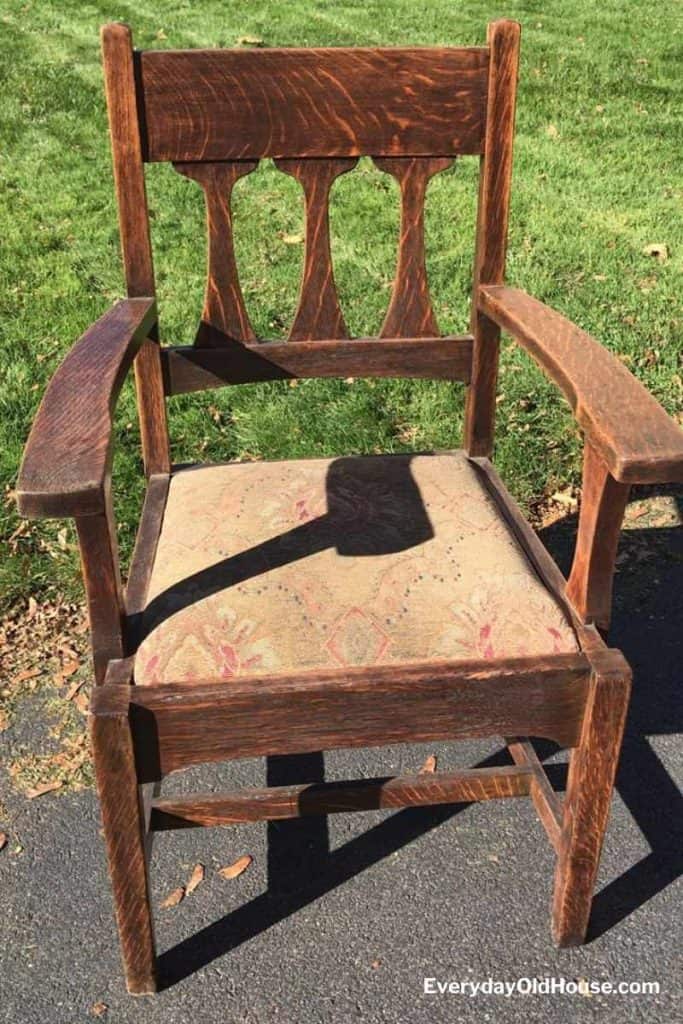
Admittedly it’s not my style of chair. But considering it looked older (early 1900s?), was from Elizabeth’s mansion and had a gorgeous wood grain, I couldn’t resist.
Now, do I think this chair was owned by Elizabeth Boit? Did she sit in this very chair as she championed workers right? Honestly, chances are slim. There have been several owners of the house since Elizabeth. But I couldn’t leave this chair to be tossed to the insides of a garbage truck.
Disclaimer
Obviously, the best way to refinish a piece is hire a professional. If you have a treasured heirloom that needs restoring and you’re new to DIY wood furniture restoration, then don’t do it solo. Hire someone.
But if you are like me, and pick up random chairs off the side of the road that was destined for the landfill, then let’s learn together, OK?
Dull Tiger Oak Furniture: Lessons Learned
Posting pictures of my street-side findings on a Facebook antique furniture restoration group led to a plethora of information. While admittedly in these community groups you must pick through the comments to get a sense of who’s knowledgeable (and who’s not). BUT it can be well worth the effort.
And here’s 4 Things that I learned:
- The chair likely from the early 20th Century
- That gorgeous wood grain is called tiger oak
- A way to refresh the dull wood without losing the grain
- How to clean the seat upholstery
1. Age of Chair/ History of Tobey Furniture
When I posted the photo on the Facebook antique furniture restoration group within the day someone posted this photo from a auctioneers website that matched my chairs perfectly!

Another person mentioned the Tobey Furniture Company 1901 catalog entitled “New Furniture in Weathered Oak” that looked a lot like my chair!!! And it looks like this chair with stylized tulip back also came without armrests. The catalog (along with many other vintage furniture catalogs like Sears) is available on archive.org

Who Was the Tobey Furniture Company?
Upon further digging I found that Tobey Furniture Company made furniture for almost 100 years in Chicago starting around 1856, with peak production in the early 1900s. Tobey created its own furniture as well as sold furniture manufactured by the Stickley brothers, including Gustav a leader in the Craftsman furniture movement. Clients included the crem de la crem of Chicago hotels as well as US Presidents including Abraham Lincoln.
Detailed history of the Tobey Furniture Company can be found here.
2. What is Golden or Tiger Oak Wood?
Tiger oak is created through a specific method of milling called quarter sawing (versus plain sawing). I don’t fully understand it, but it’s related to the angle at which a log is sawn. To get that gorgeous wood grain, logs are cut a particular angle (60 degrees or 90 degree) to create wedge-shaped quarters.
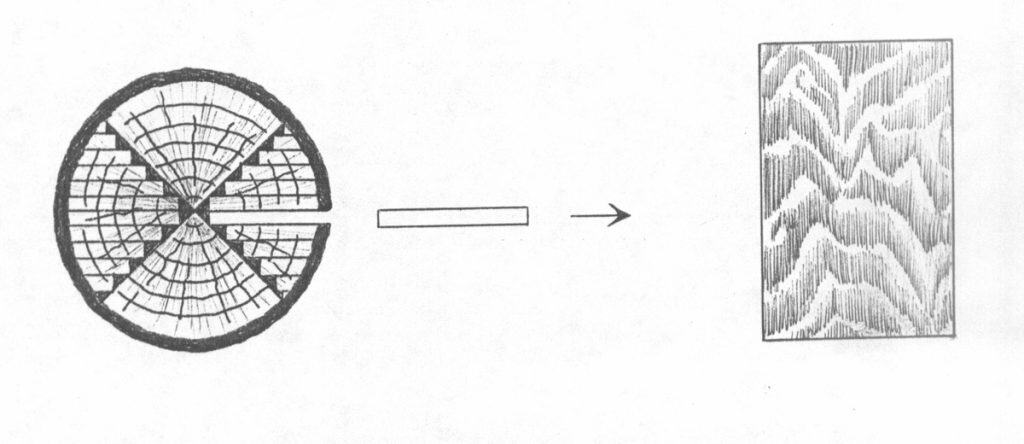
This milling process isn’t limited to just oak. Other types of wood are quarter-sawn. But with oak, the resulting wood grain resembles a “tiger’s eye”.
Pros and Cons
The first pro is that obviously gorgeous wood grain. The milling process of quarter-sawing logs at those particular angles tend to produce more stable, sturdier wood.
However, it comes at a price. Quarter-sawing produces less lumber from each log, making it a wasteful, less-efficient way to using natural resources. Combined with additional time and labor to rotate the logs to cut, ultimately makes quarter-sawn wood, and furniture, more expensive.
When was Tiger Oak Popular?
The high time for “Golden Oak” furniture lasted about 40 years – from the 1880s to the second decade of the 20th century.
As further discussed in further detail here (sidenote – the article’s author is the “Furniture Detective” – check him out), during the Colonial days, oak was a huge source of wood for furniture since it was so readily available. But the Victorian era caught the attention of the fancier woods – mahogany and walnut.
But during the later years of the 19th century, there was a shift back to oak. Why? First was the new, quickly growing middle class, who couldn’t afford the more formal woods. Plus, walnut was growing scarcer due to its high demand by Victorian society.
Fine furniture makers and mass-produced factories (including mail-order catalogs) turned back to white oak as a solution. Some folks view white oak as plain, so craftsmen and manufacturers enhanced the natural beauty of the wood was enhanced by two methods.
First was quarter sawing an oak log to reveal the startling pattern of the flecks of the medullary rays, the “tiger’s eyes” in the oak. The second was an application of shellac sometimes tinted with yellow ochre to produce the tiger eyes.
To conserve white oak (and cut costs), some furniture factories turned toward other methods to produce tiger oak furniture. For example, they applied a thin sheet of tiger eye veneer over plain-sawn wood. Or rolled an oak grain finish over the plain-sawn wood to give the impression of tiger’s eye oak, like in the photo below. Unfortunately, many manufacturers sold this knock-off version of tiger oak, cheating customers.
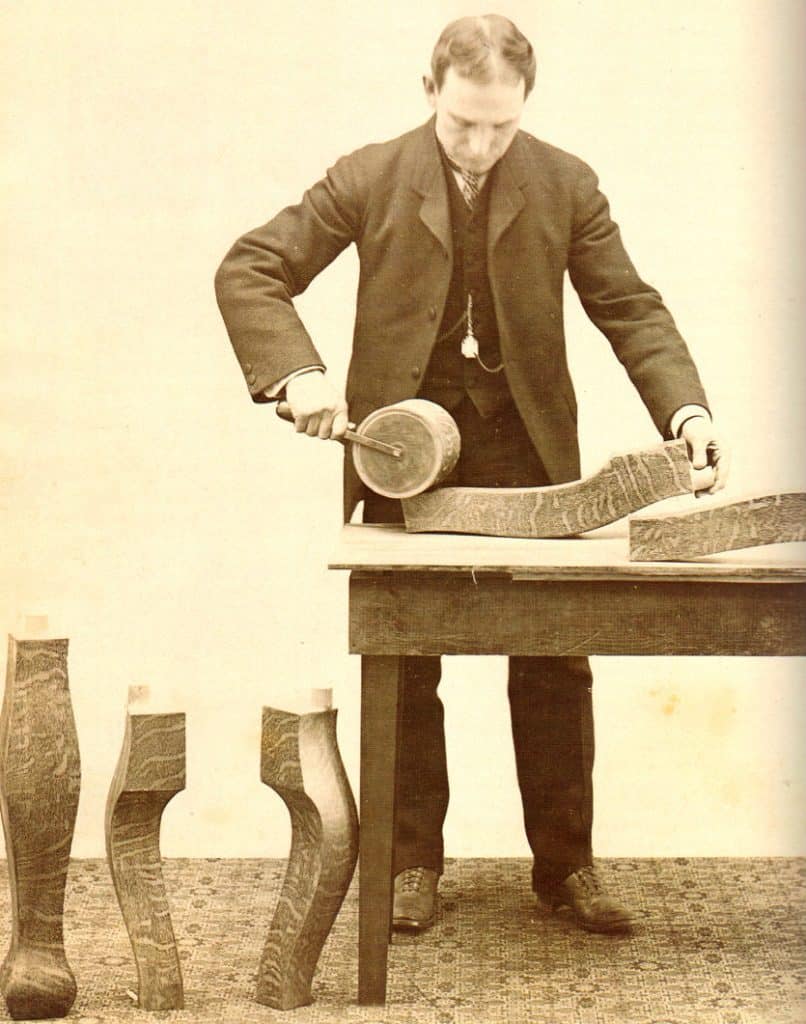
3. Refresh Dull Tiger Oak
This chair was in amazing shape – from a sturdy frame to an uncompromised finish. Sure there were a few dings and imperfections, but I chose to embrace the patina as part of its charm.
In my amateur opinion and skill, I decided to give it a refresh. To restore dull tiger oak furniture (the wood part), I needed to do these 3 things:
- Identify Finish
- Clean Chair
- Protect Finish
Identify Finish
Part of restoring a piece is knowing what you are working with, including the finish. Using this guidance, I used denatured alcohol and acetone to determine that the finish was shellac.
- Use a cotton swab with acetone on it and apply to the wood. If it becomes tacky, than it is shellac or varnish and if it beads, it has a polyurethane finish. If it is lacquer, the lacquer will dissolve completely.
- Shellac and Varnish – To differentiate between shellac and varnish, use a cotton swab to apply denatured alcohol (ethanol). Varnish will react slowly, but shellac will dissolve right away.
Cleaning Shellacked Wood Furniture
Folks on the Facebook group recommended cleaning the chair with a rag dipper in mineral spirits. It would clean away any of the dark gunk but leave the shellack.
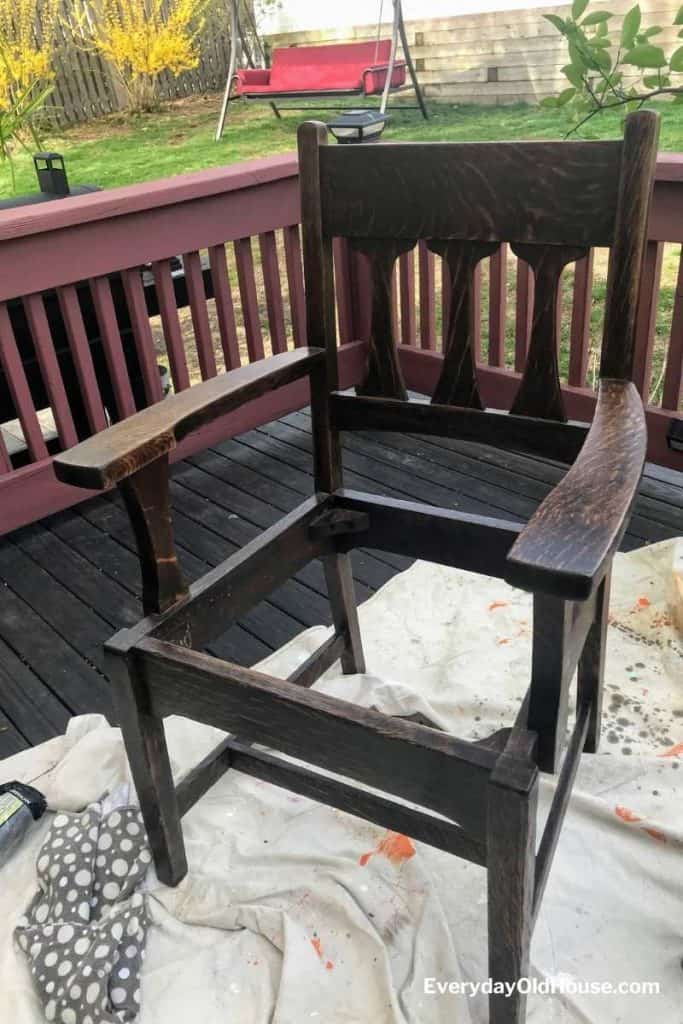
Sanding – Yes or No?
In case you are wondering why I chose not to sand, here’s my thought process. While there is a good chance that my tiger oak furniture is legit (i.e. truly quarter-sawn white oak) I was still hesistant.
What if I’m wrong and it’s actually veneer? (I didn’t see any evidence of veneer, but I’m no expert). Or what if the dull tiger oak grain was “painted” over lesser-quality wood? As mentioned above, some furniture manufacturers cheated customers into thinking they were buying real tiger oak with this chemical roll. Again, I’m no expert. I’m not taking a chance. This grain on this chair is too beautiful.
Protect Chair
With a nice clean chair, it was time to protect it and restore some of its luster. It was recommended on the Facebook Group that I use a dry wax and hemp oil or linseed oil. I wasn’t sure which one to choose, so honestly, I went with the dry wax recommendation since the person also gave detailed directions on how to use it.
Two waxes were specifically recommended – Liberon Black Bison and Kingdom Restoration’s American Custom Paste Wax.
I took a shine (pun intended ?) to Kingdom Restoration since it is headquartered in Rocky Mount, NC. At least 1-2 times a year I drive from Boston through Rocky Mount on route to visit family in Wilmington, NC. And that Rocky Mount exit sign on I-95 is a welcome sight that we have crossed into North Carolina and almost to our destination.
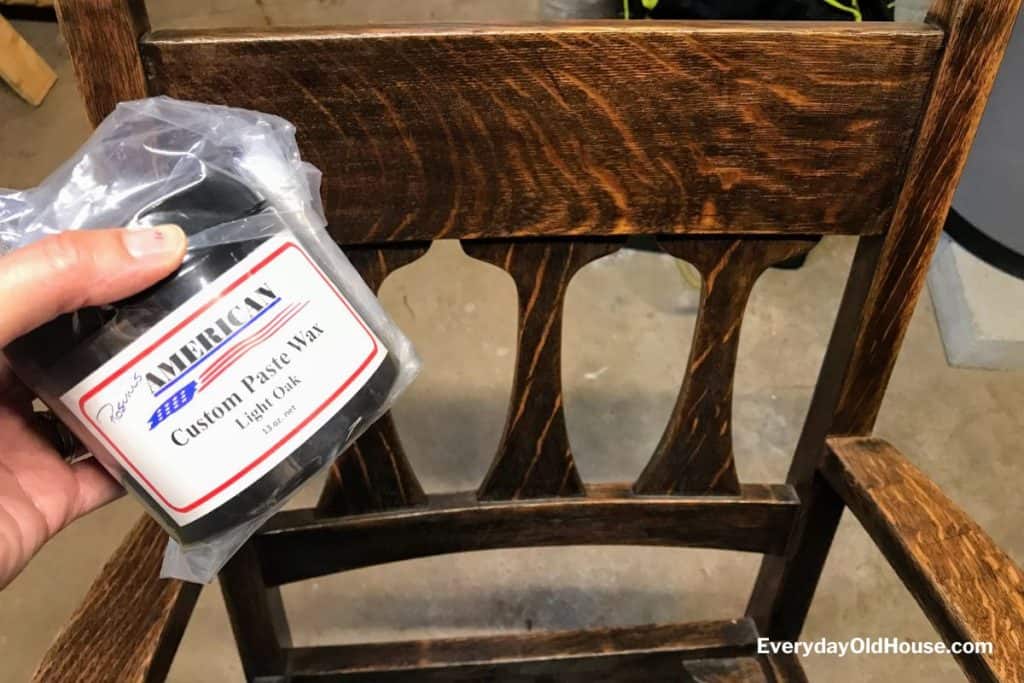
I emailed the Restoration’s America with a photo of my chair asking for a recommendation. They answered promptly with a recommendation to try their American Custom Paste Wax in Light Oak. They offered that a darker color wax would hide the brilliance of the orange.
The wax was extremely easy to work with, and the directions were straight forward. I would definitely use this wax again.
Using a clean cotton cloth, apply in circular motions. If applying with a #0000 steel wool pad, apply following the grain. Allow to dry overnight and then buff with another soft cotton cloth.
The instructions recommend using the waxing in a highly ventilated area. And I concur! It is incredibly smelly!
4. Clean Upholstery
The upholstery on the chair has seen many decades of use. Based on the recommendation on the Facebook Antique Furniture Restoration group, I cleaned the upholstery by doing the following:
1. Lightly vacuumed cushion with soft brush attachment
2. Carefully removed the staples using a tack puller and pliers

3. Soaked the material in a mixture of cold water and Arm & Hammer Super Washing Soap for a few hours. NO hot water and no wringing. When the water turned brown, I’d change out the water. It took 3 water changes for the water to stay somewhat clear.
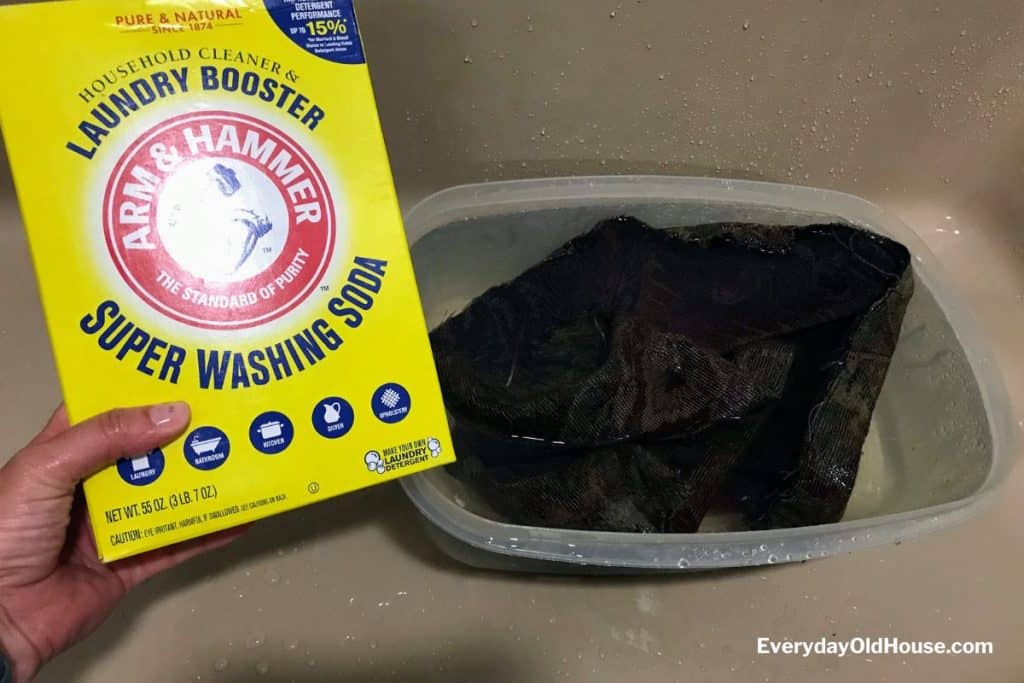
Using the spray nozzle in my shower, I gently rinsed from back to front to push back any remaining soap.
Then I set the wet tapestry between two towels and rolled out the excess water with a rolling pin. Do NOT wring or twist the tapestry.
Once the tapestry was fully dry, I stapled back onto the cushion.
Honestly, I thought after washing that the colors would pop more than they did. But I guess after a century of use and potentially sitting near a sunny window, it’s as colorful as it will get. Ultimately, I’m ok with it for now. Perhaps in the future I will consider covering it with a nice piece of leather.
If you can’t save the tapestry, check out this tutorial on how to make a bench cushion cover (it will work for any seat size).
Restored!!!
Here’s the finished product! Admittedly not a significant transformation, but I don’t believe this chair actually needed it. It just needed a teeny bit of love and TLC to refresh that dull tiger oak.
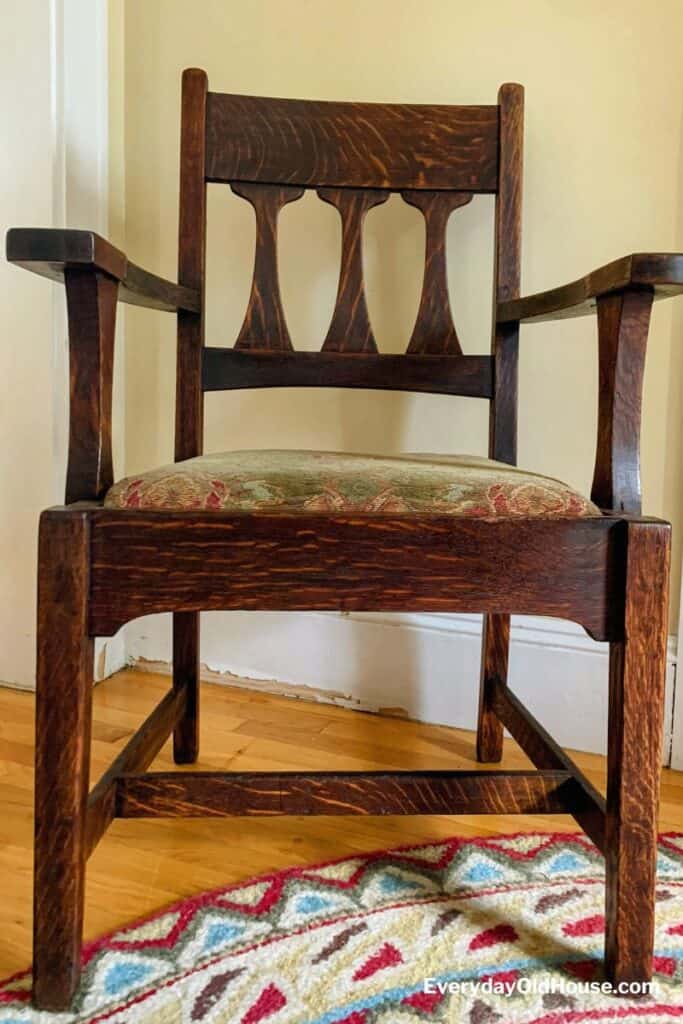
It was the perfect project for this newbie to learn how to navigate the online Facebook antique restoration group to learn more about tiger oak wood and how to protect its beauty. Plus I had the opportunity to try out a new-to-me finishing product – wax.
Now I just need to find a place to put this chair in my house…
Related Posts
Want to be the first to know about new posts? Be sure to follow me on Pinterest, Facebook, Instagram or Twitter of even Etsy! Or better yet… Subscribe below!
My monthly (admittedly sometimes more, sometimes less….) emails are like receiving a unexpected letter from an old friend WITHOUT needing to put on your slippers and walk out to your mailbox…. See? I got ya, my friend!)
[Note: My posts are proudly connected to these amazing link parties full of DIY ideas and inspiration!]

